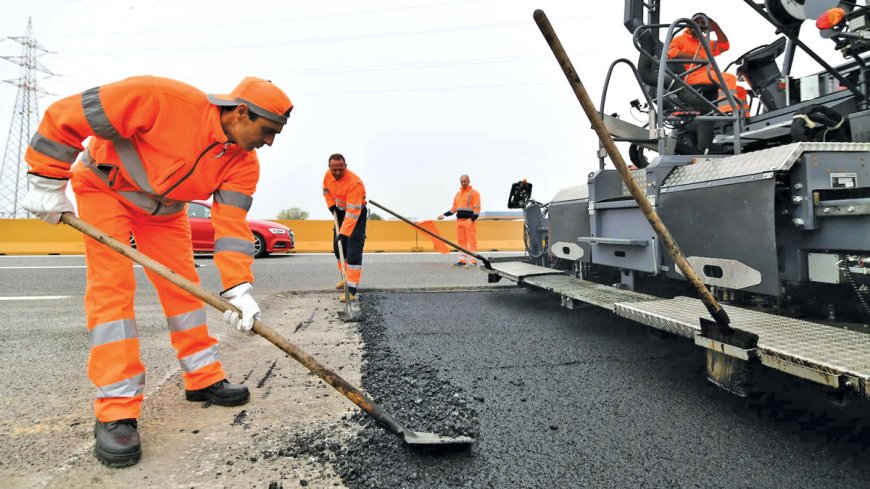Globally, innovative solutions in roadway materials are paving the way for a more sustainable future toward resilient infrastructure by utilizing environmentally friendly alternatives to natural resources. With an emphasis on waste-to-wealth initiatives, the Indian Institute of Technology Tirupati (IITT) has embarked upon integrating eco-friendly materials into infrastructure, indeed aligning with the Government of India Swachh Bharat Mission and the United Nations Sustainable Development Goals. Notwithstanding, the development and implementation of green roadway products have become topmost priority, which encompasses incorporation of durable yet marginal and locally available industrial waste materials such as rubber, plastic, construction & demolition wastes, composite wastes, municipal solid waste incineration fly ash, pond ash, ground granulated blast-furnace slag, rice husk ash, biochar, lignin, and many more in various layers of the pavement systems. Intriguingly, these waste materials can be effectively utilized in producing durable roadways that can outperform conventional products, thus promoting environmental stewardship, consequential of supporting circular economy and waste-to-wealth concepts. Figure 1 shows a few variants of the industrial waste materials used in creating many types of waste modified mixtures at IITT that have demonstrated potential use as roadway products. A glimpse of the various waste-derived roadways systems of products are described as follows.
Are recycled plastics & crumb rubber system of products a solution towards resilient roads?
The continuous accumulation of waste plastics and end-of-life tyres poses a significant environmental hazard. However, integrating recycled plastics, crumb rubber, and tyre-derived aggregates into asphalt mixtures through wet, dry, and/or semi-dry processes offers an innovative solution, as these modified mixtures not only address solid waste management but also conserve natural resources and enhance pavement performance. The state-of-the-art performance tests conducted at IITT have revealed superior characteristics of plastic-rubber modified mixtures and exhibited augmented cracking resistance, increased stiffness, and improved thermal stability. In a practical setup, a one-km roadway stretch would be able to utilize about 12.6 tons of crumb rubber and 7.6 tons of recycled plastics, paving the way for sustainable and high-performing infrastructure solutions, mainly stemming from the utilization of two abundantly available waste materials in asphalt binders and mixtures: plastic and crumb rubber.

Activated rubber utilizing industrial waste: Are we transitioning towards modified asphalt-rubber?
Another transformative innovation is the activation of crumb rubber using industrial waste materials such as fly ash, pond ash, ground granulated blast-furnace slag (GGBFS), steel slag, mill scale slag, and silica fumes. The waste-to-wealth approach facilitates the creation of a wide variety of industrial waste-based modified asphalt-rubber (MAR), a next-generation green construction material, thus creating a resilient, durable, and sustainable product suitable for modern roadway infrastructure. In the real field scenario, a one-km single-lane roadway can incorporate 30 tons of MAR products, effectively recycling 18 tons of crumb rubber and 2.4 tons of many variants of industrial wastes. Interestingly, beyond waste diversion, the superior resilience and longevity of MAR underscore its potential in addressing both industrial waste management and tyre disposal challenges in a concerted manner, exemplifying the ‘waste-to-wealth’ philosophy.
Warm-mix asphalt: would synthetic zeolites created with industrial by-products be a tangible waste-to-wealth technology?
A different application of the waste-to-wealth approach in infrastructure comes with the innovative use of synthetic zeolites, primarily developed using low-cost environmentally friendly raw materials under the larger umbrella of warm-mix asphalt (WMA) technology. During the last few years, IITT has been successful in indigenously developing synthetic zeolites using natural clays (montmorillonite K10 and bentonite), agricultural by-products (rice husk and rice husk ash), and industrial wastes (fly ash from thermal power plants) that effectively reduce the production temperatures of asphalt mixtures by at least 15-20oC, consequential of alleviating the environmental footprint of roadway construction and epitomizing sustainable practices through transforming waste materials into valuable resources. Pragmatically, the amount of rice husk ash and fly ash that can be utilized to pave a one-km stretch of road would require about 12.6 and
4 tons, respectively.
Composite wastes: Can we not move from landfills to highways?
Fibre-reinforced polymer (FRP) composites, known as “next-generation materials”, offer exceptional mechanical properties for aerospace, defence, renewable energy, sports, and automotive applications. However, the non-biodegradable nature of FRP due to irreversible crosslinking poses significant reuse and recycling challenges. Derived composite wastes (CW) from FRP recyclates has been found to enhance pavement performance by improving flexural strength and toughness. At IITT, CW has been utilized in pervious concrete (PC), which also proposes to recycle about 1.5-4 tons of CW per lane km of PC, a promising process of diverting wastes from landfills to highways. On a larger scale, incorporating CW into asphalt and/or cement concrete as an additive or partial aggregate replacement offers scalable solutions for responsible disposal, improved road performance, and resource conservation. Additionally, research on steel slag aggregate-based PC pavements at IITT has shown vast potential to mitigate urban heat island effects while maintaining pavement sustainability, highlighting effective strategies for waste management, and upgraded road performance.
Municipal solid waste incineration fly ash: Isn’t it better to utilize it as a sustainable modifier than leaching the ground surface?
The generation of municipal solid wastes is projected to reach 3.2 billion tons by 2050, which poses significant environmental challenges. While incineration can reduce raw wastes significantly, it can be detrimental to the ecosystem as it would produce hazardous Municipal Solid Waste Incineration Fly Ash (MSWIFA). Nonetheless, its disposal has been limited to cement and concrete industries, which is not weighty in today’s need for sustainable development. In this context, IITT has begun exploring utilization of MSWIFA as a credible modifier for asphalt binders and mixtures using wet, dry, and/or semi-dry processes. Preliminary rheological testing has enhanced asphalt performance, while also addressing rutting and fatigue at optimal MSWIFA dosages. Toxicity Characteristic Leaching Procedure testing confirmed reduced leaching risks through binder coating, thus potentially improving environmental safety. Practically, over 30 tons of MSWIFA could be used per lane km via the wet process, thus assuaging ground surface contamination.
Is waste cooking oil a flexible solution for aging infrastructure?
Globally, 57.51 million metric tons of waste cooking oil (WCO) are generated annually, with India contributing nearly 1.135 million metric tons. It is noteworthy that WCO has been found to rejuvenate aged asphalt by restoring its flexibility and extending pavement life by manifold, which indeed follows the principles of circular economy. Pilot studies at IITT has shown that WCO-based materials can improve low and intermediate temperature performance, reducing viscosity for smoother paving (better workability), and supporting the blending of rubber-modified asphalt, thus, creating durable pavements through reuse of WCO and waste rubber in roadway applications.
Beyond technical benefits, WCO can also reduce reliance on virgin petroleum products, thereby resulting in the conservation of natural resources and mitigation of environmental impacts.
Lignin: A plant-based solution for modern pavements?
Lignin, a natural polymer derived from plant biomass is gaining attention as a sustainable additive for virgin asphalt binders. Sourced from pulp, paper, and biofuel industries,
the incorporation of 20% lignin by weight
of the asphalt binder has been found to significantly improve high temperature performance, enhanced pavement durability while diverting the industrial and agricultural wastes into wealthier roadway products.
IITT has successfully blended lignin
modified asphalt binders that foster the “waste-to-wealth” philosophy in the broader areas of sustainable infrastructure development in the realm of agricultural waste reuse and recycle.
Waste-to-wealth and circular economy principles of roadway infrastructure unearthed through a lifecycle perspective
The shift of road construction industry towards circular economy principles emphasizes cleaner and resource-efficient technologies, chiefly to balance resource extraction and waste generation. Transitioning from a linear “take-make-dispose” model, the lifecycle impacts of road construction spanning across raw material extraction, construction, maintenance, and end-of-life must be assessed on a mandatory basis. In light of the perpetual generation of waste from “hard-to-abate” industries, the development of waste-derived pavement products offers a strategic solution that is demonstrably effective in both environmental and economic aspects. Substituting conventional
pavement materials with recycled alternatives, particularly those sourced from domestic or industrial wastes alleviates landfill burdens as well as conserves valuable natural resources. Further, incorporating toxic or hazardous materials into sections such as the sub-surface and/or surface wearing courses has effectively immobilized heavy metal leaching due to the encapsulating effect of the asphalt binder, plausibly contributing to a more sustainable and responsible development of the pavement infrastructure. Overall, the strategic shift also offers tremendous potential to reduce the carbon footprint of pavement systems/products, thereby promoting sustainability and environmental responsibility. Undoubtedly, the utilization of domestically sourced industrial wastes mitigates the environmental impacts by several times compared to the international imports, clearly paving the way towards sustainable construction with reduced carbon footprints and circularity in the transportation infrastructure.

Krishna Prapoorna Biligiri
Professor, Department of Civil & Environmental Engineering, Indian Institute of Technology (IIT) Tirupati
With input from:
Shobhit Jain, Postdoctoral Researcher, Department of Civil & Environmental Engineering, IIT Tirupati
Neetu Gopakumar, Sheikh Hazim, Srinivas Jadala, Harmandeep Kaur, Sri Gangadhar Mattaparthi, Spoorthy Bannur Murthy, and Namitha Sudan; Doctoral Research Scholars, IIT Tirupati
Sazid Ansari, Vatsalya Gawande, Yeronika Gummadi, Renuka Subhash Wagh; Postgraduate Researchers, IIT Tirupati










